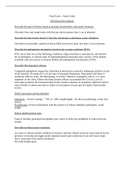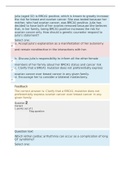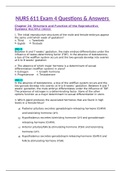Was brca1 pos Study guides, Class notes & Summaries
Looking for the best study guides, study notes and summaries about Was brca1 pos? On this page you'll find 5 study documents about Was brca1 pos.
All 5 results
Sort by

-
NUR-631-Final Exam-Study Guide- Grand Canyon University
- Exam (elaborations) • 15 pages • 2023
-
- $8.99
- 1x sold
- + learn more
Final Exam – Study Guide Definitions/Descriptions Describe the type of lesions found in psoriasis & seborrheic and actinic keratosis. Elevated, firm, and rough lesion with flat top surface great er than 1 cm in diameter Describe the skin lesions found in Varicella (chickenpox) and herpes zoster (shingles). Elevated circumscribed, superficial lesion filled with serous fluid, less than 1 cm in diameter Describe the pathogenetic mechanism of polycystic ovarian syndrome (POS). POS has at least two...

-
NUR-631-Final Exam-Study Guide- Grand Canyon University
- Exam (elaborations) • 15 pages • 2023
-
- $9.49
- + learn more
Final Exam – Study Guide Definitions/Descriptions Describe the type of lesions found in psoriasis & seborrheic and actinic keratosis. Elevated, firm, and rough lesion with flat top surface great er than 1 cm in diameter Describe the skin lesions found in Varicella (chickenpox) and herpes zoster (shingles). Elevated circumscribed, superficial lesion filled with serous fluid, less than 1 cm in diameter Describe the pathogenetic mechanism of polycystic ovarian syndrome (POS). POS has at least two...

-
NUR-631-Final Exam-Study Guide- Grand Canyon University
- Exam (elaborations) • 14 pages • 2021
-
- $10.99
- 3x sold
- + learn more
Final Exam – Study Guide Definitions/Descriptions Describe the type of lesions found in psoriasis & seborrheic and actinic keratosis. Elevated, firm, and rough lesion with flat top surface great er than 1 cm in diameter Describe the skin lesions found in Varicella (chickenpox) and herpes zoster (shingles). Elevated circumscribed, superficial lesion filled with serous fluid, less than 1 cm in diameter Describe the pathogenetic mechanism of polycystic ovarian syndrome (POS). POS has at least two...

-
Western Governors University; NURSC475/ NURS C475_ Quiz 2 Answered Complete answers/feedback
- Exam (elaborations) • 12 pages • 2021
-
- $15.78
- + learn more
NURS C475 Quiz 2 Answered Julia (aged 32) is BRCA1 positive, which is known to greatly increase the risk for breast and ovarian cancer. She was tested because her mother, who had ovarian cancer, was BRCA1 positive. Julia has decided to have both of her ovaries removed because she believes that, in her family, being BRCA1 positive increases the risk for ovarian cancer only. How should a genetic counselor respond to Julia’s statement? Select one: a. Accept Julia’s explanation as a manifestatio...

-
NURS 611 Exam 4 Questions & Answers (test-bank) Latest 2019/20 verified guide, Answers explained - Maryville University Of St. Louis.
- Exam (elaborations) • 139 pages • 2020
-
- $30.49
- 2x sold
- + learn more
NURS 611 Exam 4 Questions & Answers Chapter 24: Structure and Function of the Reproductive Systems MULTIPLE CHOICE 1. The initial reproductive structures of the male and female embryos appear the same until which week of gestation? a. Third c. Twentieth b. Eighth d. Thirtieth 2. The absence of which major hormone is a determinant of sexual differentiation (wolffian system) in utero? a. Estrogen c. Growth hormone b. Progesterone d. Testosterone 3. Which gland produces the associated horm...

Do you wonder why so many students wear nice clothes, have money to spare and enjoy tons of free time? Well, they sell on Stuvia! Imagine your study notes being downloaded a dozen times for $15 each. Every. Single. Day. Discover all about earning on Stuvia


